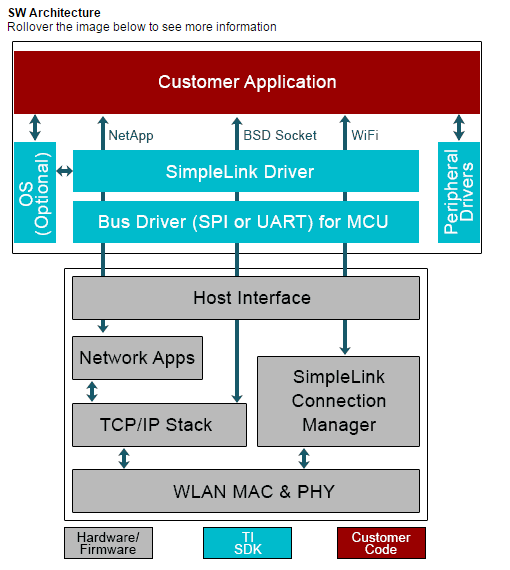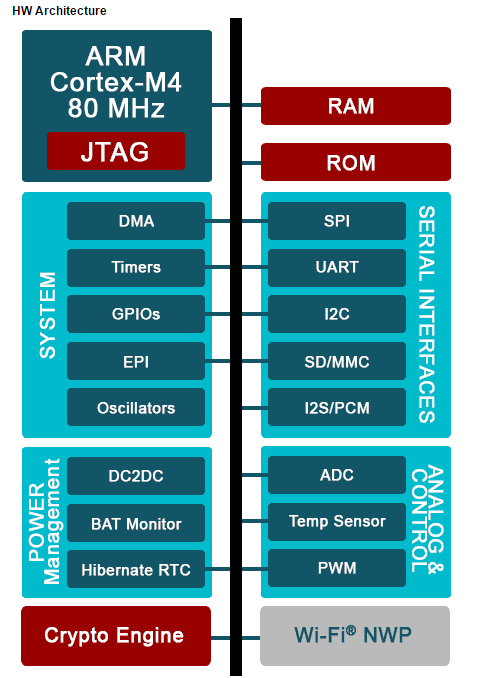本文记录通过网页控制CC3200device设备的过程。
首先贴出过程框架,如图1 sw,图2 hw

图1

图2
是图一中可以看出 Customer Application 运行在最上层。本文中指的是网页。图2为硬件框架图。
CC3200HTTP服务器支持以下功能:
1、http支持版本:1.0
2、http请求:Get和Post。
3、支持文件类型:HTML,.htm,.css,.xml,.png和.gif
4、HTML表单通过post方法提交数据
5、默认端口:80
主要用到get和post处理
以用网页控制LED亮灭为例子,说明过程。
先看网页代码
$(function() {
var sprinklerSwitch = $('#sprinklerSwitch'),
switchBtn = $('#switchImage'),
sprinkler = $('#sprinkler'),
spriklerRunning = false,
imageOn = false,
sprinklerToggle = setInterval(function() {
if (spriklerRunning) {
if (imageOn) {
sprinkler.attr('src',"images/demo-sprinkler-off.jpg");
imageOn = false;
} else {
sprinkler.attr('src',"images/demo-sprinkler-on.jpg");
imageOn = true;
}
}
}, 300);
sprinklerSwitch.click(function(){
if (switchBtn.hasClass('on')) {
switchBtn.removeClass('on');
com.TI.toggleLED('_OFF');
spriklerRunning = false;
sprinkler.attr('src',"images/demo-sprinkler-off.jpg");
imageOn = false;
} else {
switchBtn.addClass('on');
com.TI.toggleLED('_Blink');
spriklerRunning = true;
imageOn = true;
}
});
sprinklerSwitch.click(function()函数获取网页开关状态,之后调用com.TI.toggleLED函数
if(!window.com) com = new Object();
if(!com.TI) com.TI = new Object();
com.TI.toggleLED = function(whichOne) {
var LEDnum = "1",
params = "LED"+LEDnum;
params += whichOne;
$.post("No_content", {"__SL_P_ULD": params});
}
这里重点看$.post(“No_content”, {“__SL_P_ULD”: params}); 即通过post传递数据给回调函数。
函数com.TI.toggleLED()首先定义变量params:
1,OFF时params=LED1_OFF;
2,ON时 params=LED1_Blink;
然后处理http请求:以post方法发送“”_SL_P_ULD“”和params。
http服务器接受到http请求后,对用户post请求标记“”_SL_P_ULD“”调用回调函数post事件处理程序对params参数传递的内容进行处理:
1,对LED1_OFF调用GPIO_IF_Ledoff()熄灭红led,同时将led状态g_ucledstatus设为LED_BLINK,OBB任务函数OBBTask()通过判断g_ucLEDStatus再次调用GPIO_IF_LedOff()熄灭红LED.
2,对LED1_BLINK的处理过程不再赘与。
以上都是网页上的程序,通过chrome开发者工具可以观察并调试。
现在去找回调函数,运行在device上
void SimpleLinkHttpServerCallback(SlHttpServerEvent_t *pSlHttpServerEvent,
SlHttpServerResponse_t *pSlHttpServerResponse)
{
switch (pSlHttpServerEvent->Event)
{
case SL_NETAPP_HTTPGETTOKENVALUE_EVENT:
{
unsigned char *ptr;
ptr = pSlHttpServerResponse->ResponseData.token_value.data;
pSlHttpServerResponse->ResponseData.token_value.len = 0;
if(memcmp(pSlHttpServerEvent->EventData.httpTokenName.data,
GET_token_TEMP, strlen((const char *)GET_token_TEMP)) == 0)
{
float fCurrentTemp;
TMP006DrvGetTemp(&fCurrentTemp);
char cTemp = (char)fCurrentTemp;
short sTempLen = itoa(cTemp,(char*)ptr);
ptr[sTempLen++] = ' ';
ptr[sTempLen] = 'F';
pSlHttpServerResponse->ResponseData.token_value.len += sTempLen;
}
if(memcmp(pSlHttpServerEvent->EventData.httpTokenName.data,
GET_token_UIC, strlen((const char *)GET_token_UIC)) == 0)
{
if(g_iInternetAccess==0)
strcpy((char*)pSlHttpServerResponse->ResponseData.token_value.data,"1");
else
strcpy((char*)pSlHttpServerResponse->ResponseData.token_value.data,"0");
pSlHttpServerResponse->ResponseData.token_value.len = 1;
}
if(memcmp(pSlHttpServerEvent->EventData.httpTokenName.data,
GET_token_ACC, strlen((const char *)GET_token_ACC)) == 0)
{
ReadAccSensor();
if(g_ucDryerRunning)
{
strcpy((char*)pSlHttpServerResponse->ResponseData.token_value.data,"Running");
pSlHttpServerResponse->ResponseData.token_value.len += strlen("Running");
}
else
{
strcpy((char*)pSlHttpServerResponse->ResponseData.token_value.data,"Stopped");
pSlHttpServerResponse->ResponseData.token_value.len += strlen("Stopped");
}
}
}
break;
case SL_NETAPP_HTTPPOSTTOKENVALUE_EVENT:
{
unsigned char led;
unsigned char *ptr = pSlHttpServerEvent->EventData.httpPostData.token_name.data;
if(memcmp(ptr, POST_token, strlen((const char *)POST_token)) == 0)
{
ptr = pSlHttpServerEvent->EventData.httpPostData.token_value.data;
if(memcmp(ptr, "LED", 3) != 0)
break;
ptr += 3;
led = *ptr;
ptr += 2;
if(led == '1')
{
if(memcmp(ptr, "ON", 2) == 0)
{
GPIO_IF_LedOn(MCU_RED_LED_GPIO);
g_ucLEDStatus = LED_ON;
}
else if(memcmp(ptr, "Blink", 5) == 0)
{
GPIO_IF_LedOn(MCU_RED_LED_GPIO);
g_ucLEDStatus = LED_BLINK;
}
else
{
GPIO_IF_LedOff(MCU_RED_LED_GPIO);
g_ucLEDStatus = LED_OFF;
}
}
else if(led == '2')
{
if(memcmp(ptr, "ON", 2) == 0)
{
GPIO_IF_LedOn(MCU_ORANGE_LED_GPIO);
}
else if(memcmp(ptr, "Blink", 5) == 0)
{
GPIO_IF_LedOn(MCU_ORANGE_LED_GPIO);
g_ucLEDStatus = 1;
}
else
{
GPIO_IF_LedOff(MCU_ORANGE_LED_GPIO);
}
}
}
}
break;
default:
break;
}
}
- 1
- 2
- 3
- 4
- 5
- 6
- 7
- 8
- 9
- 10
- 11
- 12
- 13
- 14
- 15
- 16
- 17
- 18
- 19
- 20
- 21
- 22
- 23
- 24
- 25
- 26
- 27
- 28
- 29
- 30
- 31
- 32
- 33
- 34
- 35
- 36
- 37
- 38
- 39
- 40
- 41
- 42
- 43
- 44
- 45
- 46
- 47
- 48
- 49
- 50
- 51
- 52
- 53
- 54
- 55
- 56
- 57
- 58
- 59
- 60
- 61
- 62
- 63
- 64
- 65
- 66
- 67
- 68
- 69
- 70
- 71
- 72
- 73
- 74
- 75
- 76
- 77
- 78
- 79
- 80
- 81
- 82
- 83
- 84
- 85
- 86
- 87
- 88
- 89
- 90
- 91
- 92
- 93
- 94
- 95
- 96
- 97
- 98
- 99
- 100
- 101
- 102
- 103
- 104
- 105
- 106
- 107
- 108
- 109
- 110
- 111
- 112
- 113
- 114
- 115
- 116
- 117
- 118
- 119
- 120
- 121
- 122
- 123
- 124
- 1
- 2
- 3
- 4
- 5
- 6
- 7
- 8
- 9
- 10
- 11
- 12
- 13
- 14
- 15
- 16
- 17
- 18
- 19
- 20
- 21
- 22
- 23
- 24
- 25
- 26
- 27
- 28
- 29
- 30
- 31
- 32
- 33
- 34
- 35
- 36
- 37
- 38
- 39
- 40
- 41
- 42
- 43
- 44
- 45
- 46
- 47
- 48
- 49
- 50
- 51
- 52
- 53
- 54
- 55
- 56
- 57
- 58
- 59
- 60
- 61
- 62
- 63
- 64
- 65
- 66
- 67
- 68
- 69
- 70
- 71
- 72
- 73
- 74
- 75
- 76
- 77
- 78
- 79
- 80
- 81
- 82
- 83
- 84
- 85
- 86
- 87
- 88
- 89
- 90
- 91
- 92
- 93
- 94
- 95
- 96
- 97
- 98
- 99
- 100
- 101
- 102
- 103
- 104
- 105
- 106
- 107
- 108
- 109
- 110
- 111
- 112
- 113
- 114
- 115
- 116
- 117
- 118
- 119
- 120
- 121
- 122
- 123
- 124
可以看到device对来自web命令的相应回复。
这里需要注意,在device上运行有http事件处理函数,且处在待命状态。
void SimpleLinkWlanEventHandler(SlWlanEvent_t *pWlanEvent)
{
if(pWlanEvent == NULL)
{
UART_PRINT("Null pointer\n\r");
LOOP_FOREVER();
}
switch(pWlanEvent->Event)
{
case SL_WLAN_CONNECT_EVENT:
{
SET_STATUS_BIT(g_ulStatus, STATUS_BIT_CONNECTION);
memcpy(g_ucConnectionSSID,pWlanEvent->EventData.
STAandP2PModeWlanConnected.ssid_name,
pWlanEvent->EventData.STAandP2PModeWlanConnected.ssid_len);
memcpy(g_ucConnectionBSSID,
pWlanEvent->EventData.STAandP2PModeWlanConnected.bssid,
SL_BSSID_LENGTH);
UART_PRINT("[WLAN EVENT] Device Connected to the AP: %s , "
"BSSID: %x:%x:%x:%x:%x:%x\n\r",
g_ucConnectionSSID,g_ucConnectionBSSID[0],
g_ucConnectionBSSID[1],g_ucConnectionBSSID[2],
g_ucConnectionBSSID[3],g_ucConnectionBSSID[4],
g_ucConnectionBSSID[5]);
}
break;
case SL_WLAN_DISCONNECT_EVENT:
{
slWlanConnectAsyncResponse_t* pEventData = NULL;
CLR_STATUS_BIT(g_ulStatus, STATUS_BIT_CONNECTION);
CLR_STATUS_BIT(g_ulStatus, STATUS_BIT_IP_AQUIRED);
pEventData = &pWlanEvent->EventData.STAandP2PModeDisconnected;
if(SL_WLAN_DISCONNECT_USER_INITIATED_DISCONNECTION == pEventData->reason_code)
{
UART_PRINT("[WLAN EVENT] Device disconnected from the AP: %s, "
"BSSID: %x:%x:%x:%x:%x:%x on application's "
"request \n\r",
g_ucConnectionSSID,g_ucConnectionBSSID[0],
g_ucConnectionBSSID[1],g_ucConnectionBSSID[2],
g_ucConnectionBSSID[3],g_ucConnectionBSSID[4],
g_ucConnectionBSSID[5]);
}
else
{
UART_PRINT("[WLAN ERROR] Device disconnected from the AP AP: %s, "
"BSSID: %x:%x:%x:%x:%x:%x on an ERROR..!! \n\r",
g_ucConnectionSSID,g_ucConnectionBSSID[0],
g_ucConnectionBSSID[1],g_ucConnectionBSSID[2],
g_ucConnectionBSSID[3],g_ucConnectionBSSID[4],
g_ucConnectionBSSID[5]);
}
memset(g_ucConnectionSSID,0,sizeof(g_ucConnectionSSID));
memset(g_ucConnectionBSSID,0,sizeof(g_ucConnectionBSSID));
}
break;
case SL_WLAN_STA_CONNECTED_EVENT:
{
UART_PRINT("[WLAN EVENT] Station connected to device\n\r");
}
break;
case SL_WLAN_STA_DISCONNECTED_EVENT:
{
UART_PRINT("[WLAN EVENT] Station disconnected from device\n\r");
}
break;
case SL_WLAN_SMART_CONFIG_COMPLETE_EVENT:
{
}
break;
case SL_WLAN_SMART_CONFIG_STOP_EVENT:
{
}
break;
default:
{
UART_PRINT("[WLAN EVENT] Unexpected event [0x%x]\n\r",
pWlanEvent->Event);
}
break;
}
}
- 1
- 2
- 3
- 4
- 5
- 6
- 7
- 8
- 9
- 10
- 11
- 12
- 13
- 14
- 15
- 16
- 17
- 18
- 19
- 20
- 21
- 22
- 23
- 24
- 25
- 26
- 27
- 28
- 29
- 30
- 31
- 32
- 33
- 34
- 35
- 36
- 37
- 38
- 39
- 40
- 41
- 42
- 43
- 44
- 45
- 46
- 47
- 48
- 49
- 50
- 51
- 52
- 53
- 54
- 55
- 56
- 57
- 58
- 59
- 60
- 61
- 62
- 63
- 64
- 65
- 66
- 67
- 68
- 69
- 70
- 71
- 72
- 73
- 74
- 75
- 76
- 77
- 78
- 79
- 80
- 81
- 82
- 83
- 84
- 85
- 86
- 87
- 88
- 89
- 90
- 91
- 92
- 93
- 94
- 95
- 96
- 97
- 98
- 99
- 100
- 101
- 102
- 103
- 104
- 105
- 106
- 107
- 108
- 109
- 110
- 111
- 112
- 113
- 114
- 115
- 116
- 117
- 118
- 119
- 120
- 121
- 122
- 123
- 124
- 125
- 126
- 127
- 128
- 129
- 130
- 131
- 132
- 133
- 134
- 135
- 136
- 137
- 138
- 139
- 140
- 141
- 142
- 143
- 144
- 145
- 146
- 147
- 148
- 149
- 150
- 151
- 1
- 2
- 3
- 4
- 5
- 6
- 7
- 8
- 9
- 10
- 11
- 12
- 13
- 14
- 15
- 16
- 17
- 18
- 19
- 20
- 21
- 22
- 23
- 24
- 25
- 26
- 27
- 28
- 29
- 30
- 31
- 32
- 33
- 34
- 35
- 36
- 37
- 38
- 39
- 40
- 41
- 42
- 43
- 44
- 45
- 46
- 47
- 48
- 49
- 50
- 51
- 52
- 53
- 54
- 55
- 56
- 57
- 58
- 59
- 60
- 61
- 62
- 63
- 64
- 65
- 66
- 67
- 68
- 69
- 70
- 71
- 72
- 73
- 74
- 75
- 76
- 77
- 78
- 79
- 80
- 81
- 82
- 83
- 84
- 85
- 86
- 87
- 88
- 89
- 90
- 91
- 92
- 93
- 94
- 95
- 96
- 97
- 98
- 99
- 100
- 101
- 102
- 103
- 104
- 105
- 106
- 107
- 108
- 109
- 110
- 111
- 112
- 113
- 114
- 115
- 116
- 117
- 118
- 119
- 120
- 121
- 122
- 123
- 124
- 125
- 126
- 127
- 128
- 129
- 130
- 131
- 132
- 133
- 134
- 135
- 136
- 137
- 138
- 139
- 140
- 141
- 142
- 143
- 144
- 145
- 146
- 147
- 148
- 149
- 150
- 151
还有一个void SimpleLinkNetAppEventHandler()函数也时刻待命。
这里只用到了post。如果是从device到web,要用get。比如,在web上显示传感器的温度。用get函数获取。
理解
**post:推送
get:获取**
这里只是web和device之间数据交换 只能在连接device之后才能使用web。所以范围很小。我们需要同在有互联网的任何地方控制和监察device,所以就需要云
有云之后的一般过程为:
- 在云上注册设备
- 运行设备
- 在云上开发solution
可以在(https://exosite.com/)上注册,然后用python运行虚拟设备,体验整个开发过程。
关于HTML+css+js,在网上看到一则比较好理解的解释:
形象的说
你建一座木屋,html就是他的门,墙,柱子,屋顶,
你要是确定屋子多高,多宽,门,窗在哪,就是css确定,
你在屋子里,把椅子从南拿到北,这个过程就是js,
这三个才构成网页的页面。
《完》
























 3387
3387

 被折叠的 条评论
为什么被折叠?
被折叠的 条评论
为什么被折叠?








